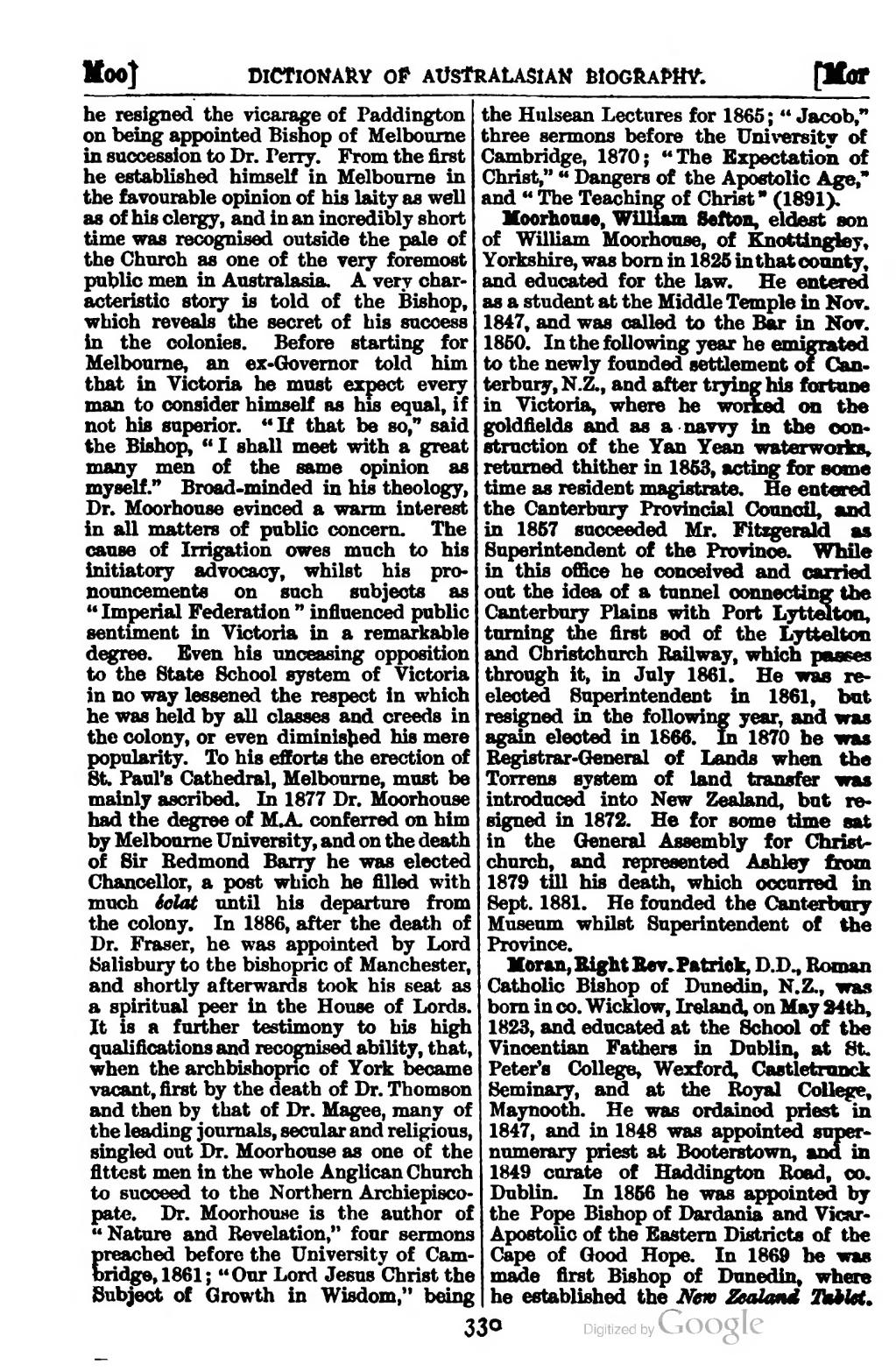he resigned the vicarage of Paddington on being appointed Bishop of Melbourne in succession to Dr. Perry. From the first he established himself in Melbourne in the favourable opinion of his laity as well as of his clergy, and in an incredibly short time was recognised outside the pale of the Church as one of the very foremost public men in Australasia. A very characteristic story is told of the Bishop, which reveals the secret of his success in the colonies. Before starting for Melbourne, an ex-Governor told him that in Victoria he must expect every man to consider himself as his equal, if not his superior. "If that be so," said the Bishop, "I shall meet with a great many men of the same opinion as myself." Broad-minded in his theology, Dr. Moorhouse evinced a warm interest in all matters of public concern. The cause of Irrigation owes much to his initiatory advocacy, whilst his pronouncements on such subjects as "Imperial Federation" influenced public sentiment in Victoria in a remarkable degree. Even his unceasing opposition to the State School system of Victoria in no way lessened the respect in which he was held by all classes and creeds in the colony, or even diminished his mere popularity. To his efforts the erection of St. Paul's Cathedral, Melbourne, must be mainly ascribed. In 1877 Dr. Moorhouse had the degree of M.A. conferred on him by Melbourne University, and on the death of Sir Redmond Barry he was elected Chancellor, a post which he filled with much éclat until his departure from the colony. In 1886, after the death of Dr. Fraser, he was appointed by Lord Salisbury to the bishopric of Manchester, and shortly afterwards took his seat as a spiritual peer in the House of Lords. It is a further testimony to his high qualifications and recognised ability, that, when the archbishopric of York became vacant, first by the death of Dr. Thomson and then by that of Dr. Magee, many of the leading journals, secular and religious, singled out Dr. Moorhouse as one of the fittest men in the whole Anglican Church to succeed to the Northern Archiepiscopate. Dr. Moorhouse is the author of "Nature and Revelation," four sermons preached before the University of Cambridge, 1861; "Our Lord Jesus Christ the Subject of Growth in Wisdom," being the Hulsean Lectures for 1865; "Jacob," three sermons before the University of Cambridge, 1870; "The Expectation of Christ," "Dangers of the Apostolic Age," and "The Teaching of Christ" (1891).
Moorhouse, William Sefton, eldest son of William Moorhouse, of Knottingley, Yorkshire, was born in 1825 in that county, and educated for the law. He entered as a student at the Middle Temple in Nov. 1847, and was called to the Bar in Nov. 1850. In the following year he emigrated to the newly founded settlement of Canterbury, N.Z., and after trying his fortune in Victoria, where he worked on the goldfields and as a navvy in the construction of the Yan Yean water works, returned thither in 1853, acting for some time as resident magistrate. He entered the Canterbury Provincial Council, and in 1857 succeeded Mr. Fitzgerald as Superintendent of the Province. While in this office he conceived and carried out the idea of a tunnel connecting the Canterbury Plains with Port Lyttelton, turning the first sod of the Lyttelton and Christchurch Railway, which passes through it, in July 1861. He was re-elected Superintendent in 1861, but resigned in the following year, and was again elected in 1866. In 1870 he was Registrar-General of Lands when the Torrens system of land transfer was introduced into New Zealand, but resigned in 1872. He for some time sat in the General Assembly for Christchurch, and represented Ashley from 1879 till his death, which occurred in Sept. 1881. He founded the Canterbury Museum whilst Superintendent of the Province.
Moran, Right Rev. Patrick, D.D., Roman Catholic Bishop of Dunedin, N.Z., was born in co. Wicklow, Ireland, on May 24th, 1823, and educated at the School of the Vincentian Fathers in Dublin, at St. Peter's College, Wexford, Castletrunck Seminary, and at the Royal College, Maynooth. He was ordained priest in 1847, and in 1848 was appointed supernumerary priest at Booterstown, and in 1849 curate of Haddington Road, co. Dublin. In 1856 he was appointed by the Pope Bishop of Dardania and Vicar-Apostolic of the Eastern Districts of the Cape of Good Hope. In 1869 he was made first Bishop of Dunedin, where he established the New Zealand Tablet.
330
